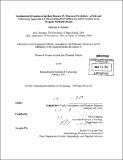Geochemical properties of the Beni Bousera (N. Morocco) peridotites : a field and laboratory approach to understanding melt infiltration and extraction in an orogenic peridotite massif
Author(s)
Manthei, Christian D. (Christian David)
DownloadFull printable version (7.004Mb)
Other Contributors
Massachusetts Institute of Technology. Dept. of Earth, Atmospheric, and Planetary Sciences.
Advisor
Oliver Jagoutz.
Terms of use
Metadata
Show full item recordAbstract
The Beni Bousera ultramafic massif is a tectonically emplaced body of upper mantle material that is exposed over 72 km2 in the Betic-Rif-Tell orogenic belt of northern Morocco. The massif is composed primarily of spinel lherzolite, although meter-scale domains of harzburgite, dunite, and veins and layers of pyroxenite are relatively common. A combined field and laboratory-based investigation of Beni Bousera has yielded a new dataset comprised of whole rock and mineral chemistry data that is used to suggest the massif is more heterogeneous than previously interpreted, and that "secondary" peridotites and dunites were formed by different petrogenic processes than the remainder of the massif. Trends in the CaO-MgO-Al 203-SiO 2 system and trace element patterns suggest partial melting of the peridotite played a significant role in the evolution of the massif, as has been previously suggested for other orogenic peridotites. Heterogeneous zones - regions throughout the massif with diverse groups of peridotites and pyroxenites - are believed to be relict melt transport channels. Peridotites and pyroxenites found in these zones show evidence of interaction with a relatively depleted melt (high Cr, low Al and Ti in mineral phases), and textures that suggest the secondary precipitation of neoblastic pyroxenes along matrix olivine grain boundaries. Rare earth element concentrations of clinopyroxene from two peridotite groups suggest equilibration in the garnet stability field, and temperatures calculated from dysprosium concentrations are usually higher than those determined from two-pyroxene thermometry. Linear major element patterns versus MgO and whole rock REE compositions of Beni Bousera dunites suggest that they cannot have formed via partial melting alone. The data collected here also suggest that the massif has experienced several mantle P/T conditions, and continuously equilibrated during exhumation and emplacement into the crust. A comparison with the geometry of the melt transport domain at Ronda, another Mediterranean peridotite body, suggests that although Beni Bousera and Ronda may be related in age of exhumation, melt may have been transported via different pathways in the two massifs.
Description
Thesis (S.M.)--Massachusetts Institute of Technology, Dept. of Earth, Atmospheric, and Planetary Sciences, 2012. Cataloged from PDF version of thesis. Includes bibliographical references (p. 18-24).
Date issued
2012Department
Massachusetts Institute of Technology. Department of Earth, Atmospheric, and Planetary SciencesPublisher
Massachusetts Institute of Technology
Keywords
Earth, Atmospheric, and Planetary Sciences.